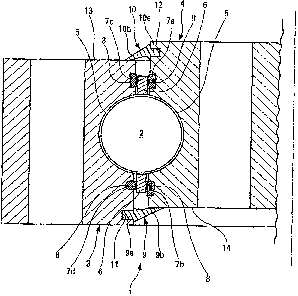Some of the information on this Web page has been provided by external sources. The Government of Canada is not responsible for the accuracy, reliability or currency of the information supplied by external sources. Users wishing to rely upon this information should consult directly with the source of the information. Content provided by external sources is not subject to official languages, privacy and accessibility requirements.
Any discrepancies in the text and image of the Claims and Abstract are due to differing posting times. Text of the Claims and Abstract are posted:
| (12) Patent: | (11) CA 2478454 |
|---|---|
| (54) English Title: | SLEWING RING |
| (54) French Title: | COURONNE DE ROTATION |
| Status: | Deemed Expired |
| (51) International Patent Classification (IPC): |
|
|---|---|
| (72) Inventors : |
|
| (73) Owners : |
|
| (71) Applicants : |
|
| (74) Agent: | SMART & BIGGAR LP |
| (74) Associate agent: | |
| (45) Issued: | 2008-11-18 |
| (22) Filed Date: | 2004-08-23 |
| (41) Open to Public Inspection: | 2005-02-27 |
| Examination requested: | 2004-08-23 |
| Availability of licence: | N/A |
| Dedicated to the Public: | N/A |
| (25) Language of filing: | English |
| Patent Cooperation Treaty (PCT): | No |
|---|
| (30) Application Priority Data: | ||||||
|---|---|---|---|---|---|---|
|
The slewing ring (1) comprises a retainer (6) in metal of a certain hardness substantially equal to the hardness of rings (3,4), which is arranged between two the rings (3,4), the retainer is integral in rotation with rolling elements (2), and holds these elements regularly spaced apart in raceway (5). At least one contact ring (7a,7b,7c,7d) made of a material of different hardness to the hardness of the rings (3,4) and of the retainer (6), is arranged between two members formed by retainer (6) and by one of the two rings (3,4), the contact ring prevents any direct contact between these two members (3,6;4,6) and is fixed to one of these two members (3,6;4,6) and is able to come into contact with the other (6,3;6,4).
Une couronne de rotation (1) comprend un dispositif de retenue (6) en métal d'une certaine dureté essentiellement égale à la dureté des couronnes (3,4), qui est placé entre deux des couronnes (3,4), le dispositif de retenue est intégré en rotation avec les éléments roulants (2), et retient ces éléments régulièrement espacés dans une cage (5). Au moins une couronne de contact (7a,7b,7c,7d) fabriquée d'un matériau de dureté différente de la dureté des couronnes (3,4) et du dispositif de retenue (6), est placée entre les deux éléments formés par le dispositif de retenue (6) et par une des deux couronnes (3,4), la couronne de contact empêche tout contact direct entre ces deux éléments (3,6;4,6) et est fixée à un de ces deux éléments (3,6;4,6) et peut venir en contact avec l'autre (6,3;6,4).
Note: Claims are shown in the official language in which they were submitted.
Note: Descriptions are shown in the official language in which they were submitted.

2024-08-01:As part of the Next Generation Patents (NGP) transition, the Canadian Patents Database (CPD) now contains a more detailed Event History, which replicates the Event Log of our new back-office solution.
Please note that "Inactive:" events refers to events no longer in use in our new back-office solution.
For a clearer understanding of the status of the application/patent presented on this page, the site Disclaimer , as well as the definitions for Patent , Event History , Maintenance Fee and Payment History should be consulted.
| Description | Date |
|---|---|
| Letter Sent | 2024-02-23 |
| Letter Sent | 2023-08-23 |
| Common Representative Appointed | 2019-10-30 |
| Common Representative Appointed | 2019-10-30 |
| Change of Address or Method of Correspondence Request Received | 2018-03-28 |
| Grant by Issuance | 2008-11-18 |
| Inactive: Cover page published | 2008-11-17 |
| Pre-grant | 2008-08-22 |
| Inactive: Final fee received | 2008-08-22 |
| Notice of Allowance is Issued | 2008-04-25 |
| Letter Sent | 2008-04-25 |
| Notice of Allowance is Issued | 2008-04-25 |
| Inactive: IPC removed | 2008-04-21 |
| Inactive: IPC removed | 2008-04-21 |
| Inactive: Approved for allowance (AFA) | 2008-03-12 |
| Amendment Received - Voluntary Amendment | 2007-11-16 |
| Inactive: S.30(2) Rules - Examiner requisition | 2007-06-11 |
| Inactive: IPC from MCD | 2006-03-12 |
| Inactive: IPC from MCD | 2006-03-12 |
| Inactive: IPC from MCD | 2006-03-12 |
| Inactive: IPC from MCD | 2006-03-12 |
| Inactive: IPC from MCD | 2006-03-12 |
| Application Published (Open to Public Inspection) | 2005-02-27 |
| Inactive: Cover page published | 2005-02-27 |
| Letter Sent | 2005-01-25 |
| Inactive: Single transfer | 2005-01-06 |
| Inactive: First IPC assigned | 2004-12-31 |
| Inactive: Courtesy letter - Evidence | 2004-10-12 |
| Inactive: Filing certificate - RFE (English) | 2004-10-08 |
| Letter Sent | 2004-10-05 |
| Application Received - Regular National | 2004-10-04 |
| Request for Examination Requirements Determined Compliant | 2004-08-23 |
| All Requirements for Examination Determined Compliant | 2004-08-23 |
There is no abandonment history.
The last payment was received on 2008-08-14
Note : If the full payment has not been received on or before the date indicated, a further fee may be required which may be one of the following
Patent fees are adjusted on the 1st of January every year. The amounts above are the current amounts if received by December 31 of the current year.
Please refer to the CIPO
Patent Fees
web page to see all current fee amounts.
Note: Records showing the ownership history in alphabetical order.
| Current Owners on Record |
|---|
| DEFONTAINE |
| Past Owners on Record |
|---|
| DANIEL TERVE |
| DIDIER CHATRY |